PROJ6000: Project Selection Methods and Initiation Documents Report
VerifiedAdded on 2022/08/31
|10
|2376
|22
Report
AI Summary
This report provides a comprehensive analysis of project selection methods and initiation documents within the context of project management. It begins with an introduction to the importance of selecting appropriate project selection approaches and then moves on to evaluate various methods applicable to the case study of SingularLogic, a software and integrated IT solutions group. The report identifies suitable project selection methods such as cost/benefit ratio, scoring model, payback period, and opportunity cost, with detailed explanations. It then discusses the processes involved in conducting these project selection methods. Furthermore, the report examines the initiation process group according to the PMBOK guide, highlighting the importance of project charter development and stakeholder identification. Finally, the report describes essential project documents, including the project charter, contracts, and risk registers, concluding with the significance of these documents for successful project completion. The report emphasizes the practical application of project management principles and provides a structured approach to project selection and initiation.

Running head: PROJ6000 PRINCIPLES OF PROJECT MANAGEMENT
PROJ6000 Principles of Project Management
Name of the Student
Name of the University
Author Note
PROJ6000 Principles of Project Management
Name of the Student
Name of the University
Author Note
Paraphrase This Document
Need a fresh take? Get an instant paraphrase of this document with our AI Paraphraser
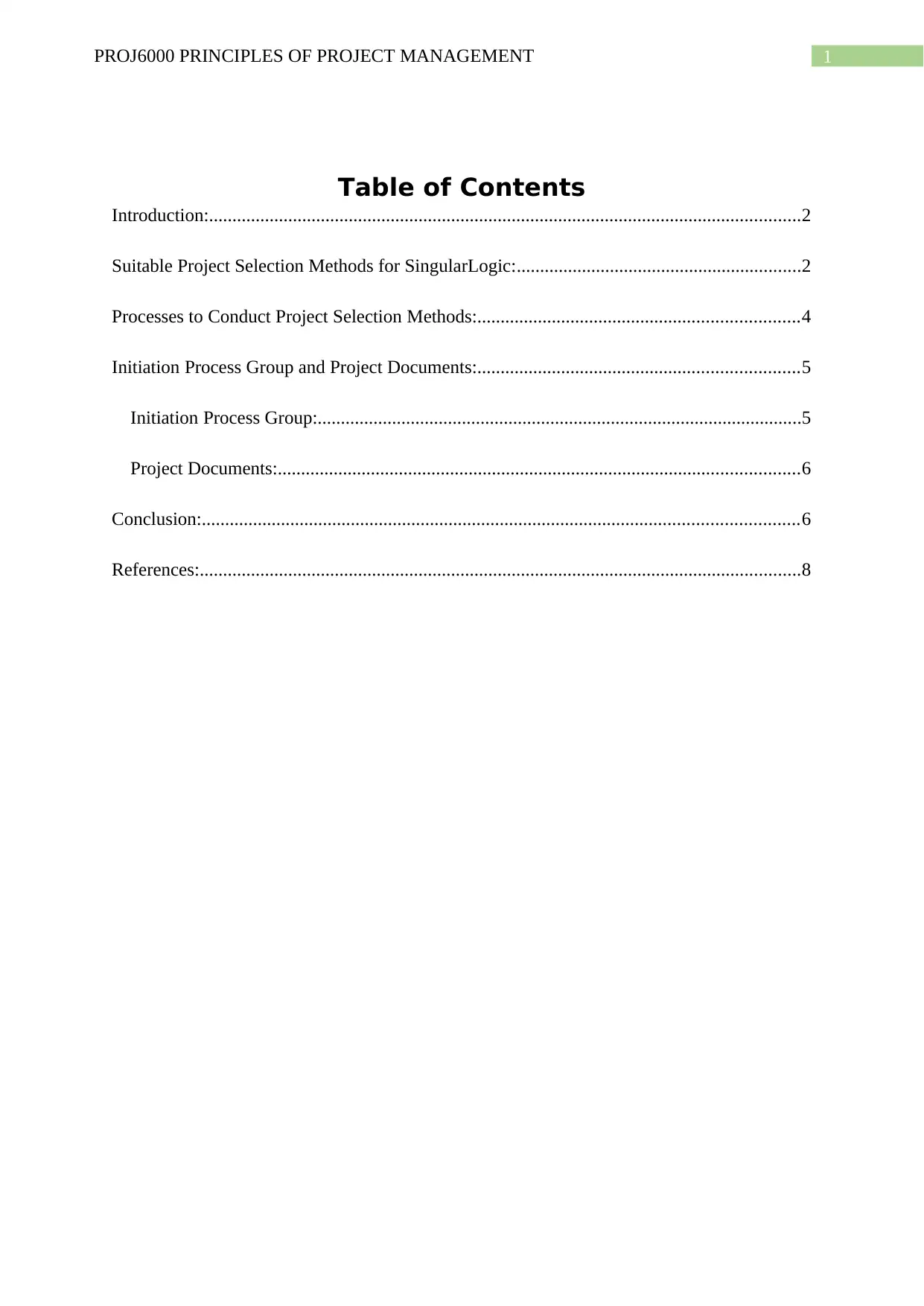
1PROJ6000 PRINCIPLES OF PROJECT MANAGEMENT
Table of Contents
Introduction:...............................................................................................................................2
Suitable Project Selection Methods for SingularLogic:.............................................................2
Processes to Conduct Project Selection Methods:.....................................................................4
Initiation Process Group and Project Documents:.....................................................................5
Initiation Process Group:........................................................................................................5
Project Documents:................................................................................................................6
Conclusion:................................................................................................................................6
References:.................................................................................................................................8
Table of Contents
Introduction:...............................................................................................................................2
Suitable Project Selection Methods for SingularLogic:.............................................................2
Processes to Conduct Project Selection Methods:.....................................................................4
Initiation Process Group and Project Documents:.....................................................................5
Initiation Process Group:........................................................................................................5
Project Documents:................................................................................................................6
Conclusion:................................................................................................................................6
References:.................................................................................................................................8
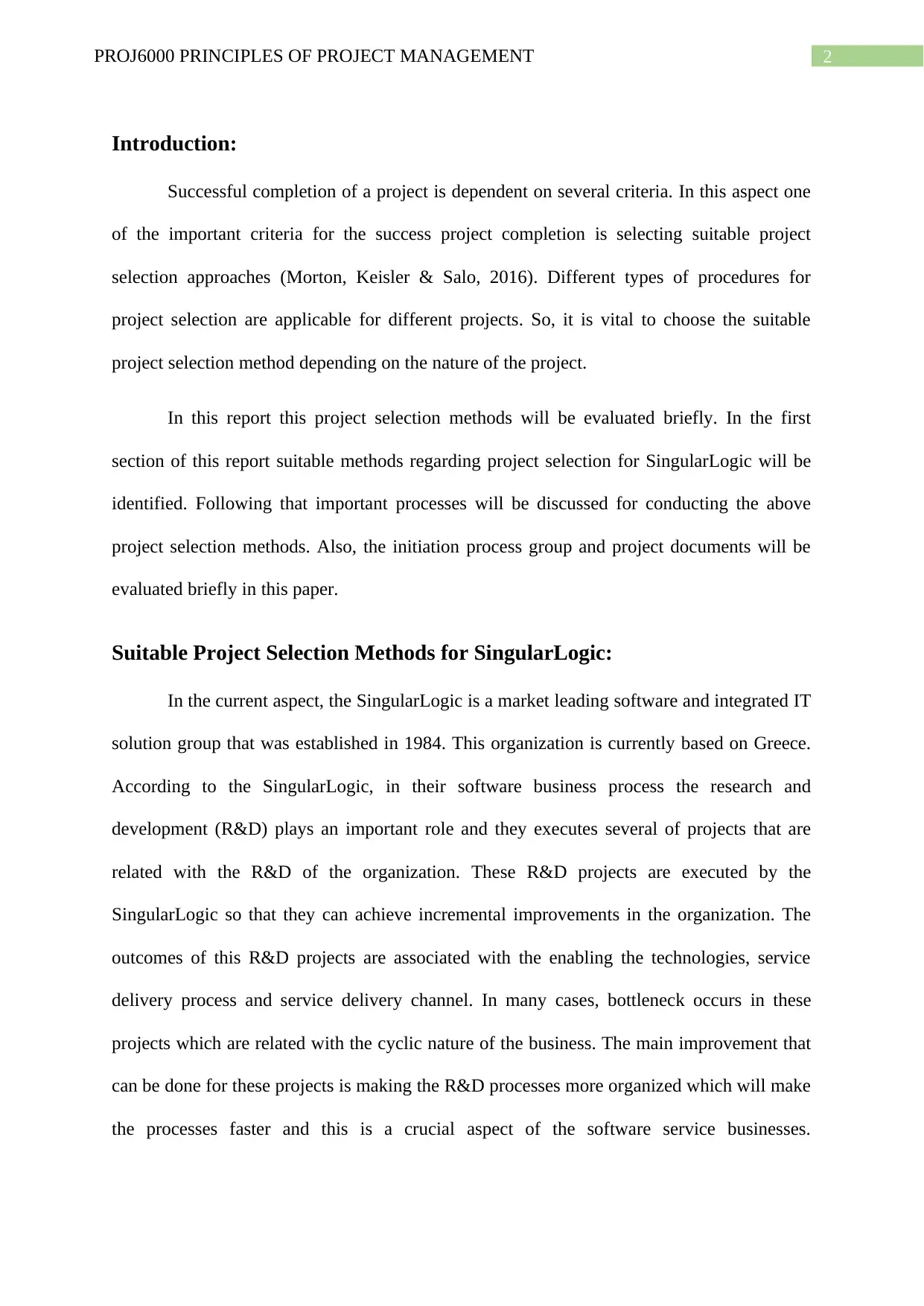
2PROJ6000 PRINCIPLES OF PROJECT MANAGEMENT
Introduction:
Successful completion of a project is dependent on several criteria. In this aspect one
of the important criteria for the success project completion is selecting suitable project
selection approaches (Morton, Keisler & Salo, 2016). Different types of procedures for
project selection are applicable for different projects. So, it is vital to choose the suitable
project selection method depending on the nature of the project.
In this report this project selection methods will be evaluated briefly. In the first
section of this report suitable methods regarding project selection for SingularLogic will be
identified. Following that important processes will be discussed for conducting the above
project selection methods. Also, the initiation process group and project documents will be
evaluated briefly in this paper.
Suitable Project Selection Methods for SingularLogic:
In the current aspect, the SingularLogic is a market leading software and integrated IT
solution group that was established in 1984. This organization is currently based on Greece.
According to the SingularLogic, in their software business process the research and
development (R&D) plays an important role and they executes several of projects that are
related with the R&D of the organization. These R&D projects are executed by the
SingularLogic so that they can achieve incremental improvements in the organization. The
outcomes of this R&D projects are associated with the enabling the technologies, service
delivery process and service delivery channel. In many cases, bottleneck occurs in these
projects which are related with the cyclic nature of the business. The main improvement that
can be done for these projects is making the R&D processes more organized which will make
the processes faster and this is a crucial aspect of the software service businesses.
Introduction:
Successful completion of a project is dependent on several criteria. In this aspect one
of the important criteria for the success project completion is selecting suitable project
selection approaches (Morton, Keisler & Salo, 2016). Different types of procedures for
project selection are applicable for different projects. So, it is vital to choose the suitable
project selection method depending on the nature of the project.
In this report this project selection methods will be evaluated briefly. In the first
section of this report suitable methods regarding project selection for SingularLogic will be
identified. Following that important processes will be discussed for conducting the above
project selection methods. Also, the initiation process group and project documents will be
evaluated briefly in this paper.
Suitable Project Selection Methods for SingularLogic:
In the current aspect, the SingularLogic is a market leading software and integrated IT
solution group that was established in 1984. This organization is currently based on Greece.
According to the SingularLogic, in their software business process the research and
development (R&D) plays an important role and they executes several of projects that are
related with the R&D of the organization. These R&D projects are executed by the
SingularLogic so that they can achieve incremental improvements in the organization. The
outcomes of this R&D projects are associated with the enabling the technologies, service
delivery process and service delivery channel. In many cases, bottleneck occurs in these
projects which are related with the cyclic nature of the business. The main improvement that
can be done for these projects is making the R&D processes more organized which will make
the processes faster and this is a crucial aspect of the software service businesses.
⊘ This is a preview!⊘
Do you want full access?
Subscribe today to unlock all pages.

Trusted by 1+ million students worldwide
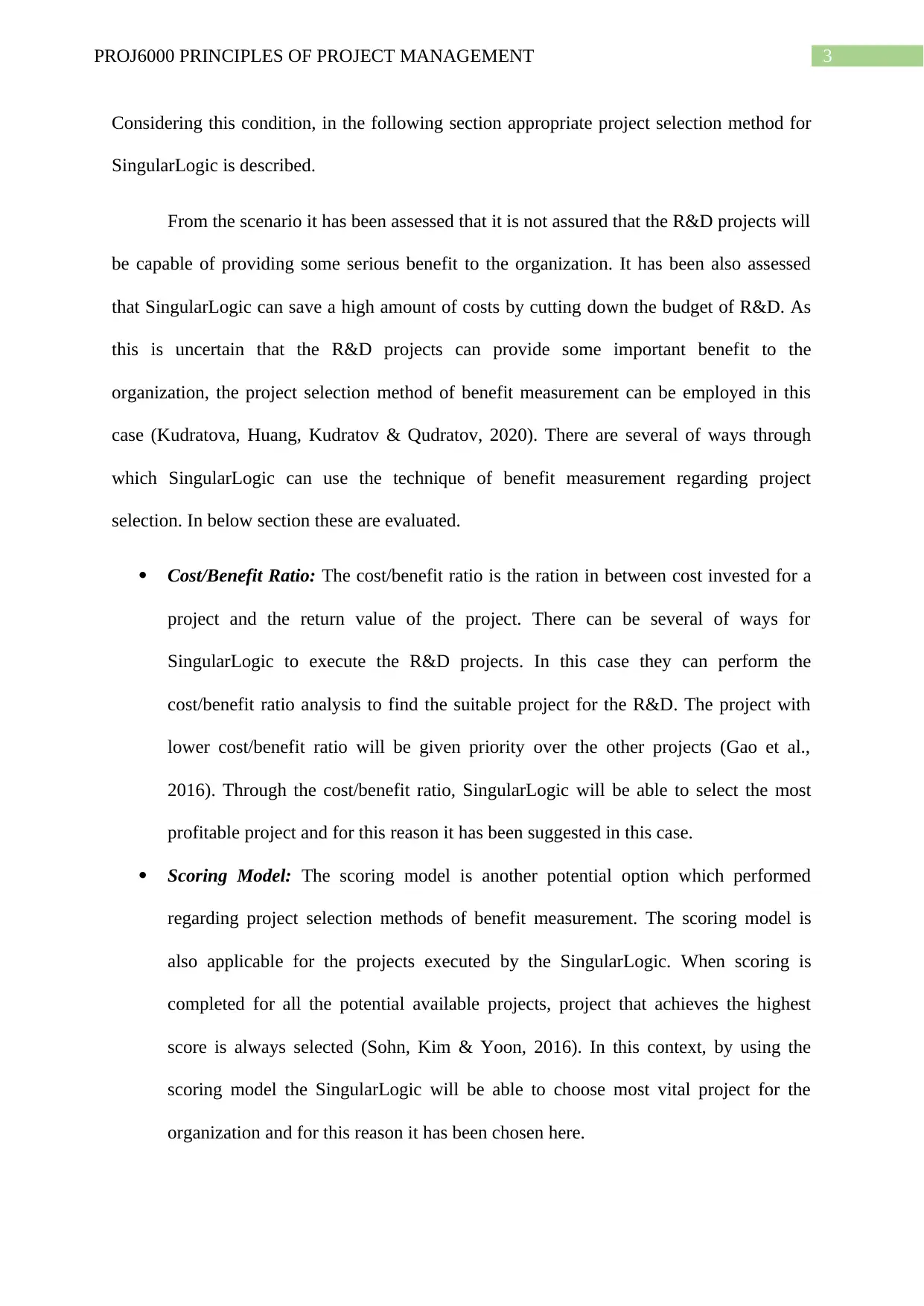
3PROJ6000 PRINCIPLES OF PROJECT MANAGEMENT
Considering this condition, in the following section appropriate project selection method for
SingularLogic is described.
From the scenario it has been assessed that it is not assured that the R&D projects will
be capable of providing some serious benefit to the organization. It has been also assessed
that SingularLogic can save a high amount of costs by cutting down the budget of R&D. As
this is uncertain that the R&D projects can provide some important benefit to the
organization, the project selection method of benefit measurement can be employed in this
case (Kudratova, Huang, Kudratov & Qudratov, 2020). There are several of ways through
which SingularLogic can use the technique of benefit measurement regarding project
selection. In below section these are evaluated.
Cost/Benefit Ratio: The cost/benefit ratio is the ration in between cost invested for a
project and the return value of the project. There can be several of ways for
SingularLogic to execute the R&D projects. In this case they can perform the
cost/benefit ratio analysis to find the suitable project for the R&D. The project with
lower cost/benefit ratio will be given priority over the other projects (Gao et al.,
2016). Through the cost/benefit ratio, SingularLogic will be able to select the most
profitable project and for this reason it has been suggested in this case.
Scoring Model: The scoring model is another potential option which performed
regarding project selection methods of benefit measurement. The scoring model is
also applicable for the projects executed by the SingularLogic. When scoring is
completed for all the potential available projects, project that achieves the highest
score is always selected (Sohn, Kim & Yoon, 2016). In this context, by using the
scoring model the SingularLogic will be able to choose most vital project for the
organization and for this reason it has been chosen here.
Considering this condition, in the following section appropriate project selection method for
SingularLogic is described.
From the scenario it has been assessed that it is not assured that the R&D projects will
be capable of providing some serious benefit to the organization. It has been also assessed
that SingularLogic can save a high amount of costs by cutting down the budget of R&D. As
this is uncertain that the R&D projects can provide some important benefit to the
organization, the project selection method of benefit measurement can be employed in this
case (Kudratova, Huang, Kudratov & Qudratov, 2020). There are several of ways through
which SingularLogic can use the technique of benefit measurement regarding project
selection. In below section these are evaluated.
Cost/Benefit Ratio: The cost/benefit ratio is the ration in between cost invested for a
project and the return value of the project. There can be several of ways for
SingularLogic to execute the R&D projects. In this case they can perform the
cost/benefit ratio analysis to find the suitable project for the R&D. The project with
lower cost/benefit ratio will be given priority over the other projects (Gao et al.,
2016). Through the cost/benefit ratio, SingularLogic will be able to select the most
profitable project and for this reason it has been suggested in this case.
Scoring Model: The scoring model is another potential option which performed
regarding project selection methods of benefit measurement. The scoring model is
also applicable for the projects executed by the SingularLogic. When scoring is
completed for all the potential available projects, project that achieves the highest
score is always selected (Sohn, Kim & Yoon, 2016). In this context, by using the
scoring model the SingularLogic will be able to choose most vital project for the
organization and for this reason it has been chosen here.
Paraphrase This Document
Need a fresh take? Get an instant paraphrase of this document with our AI Paraphraser
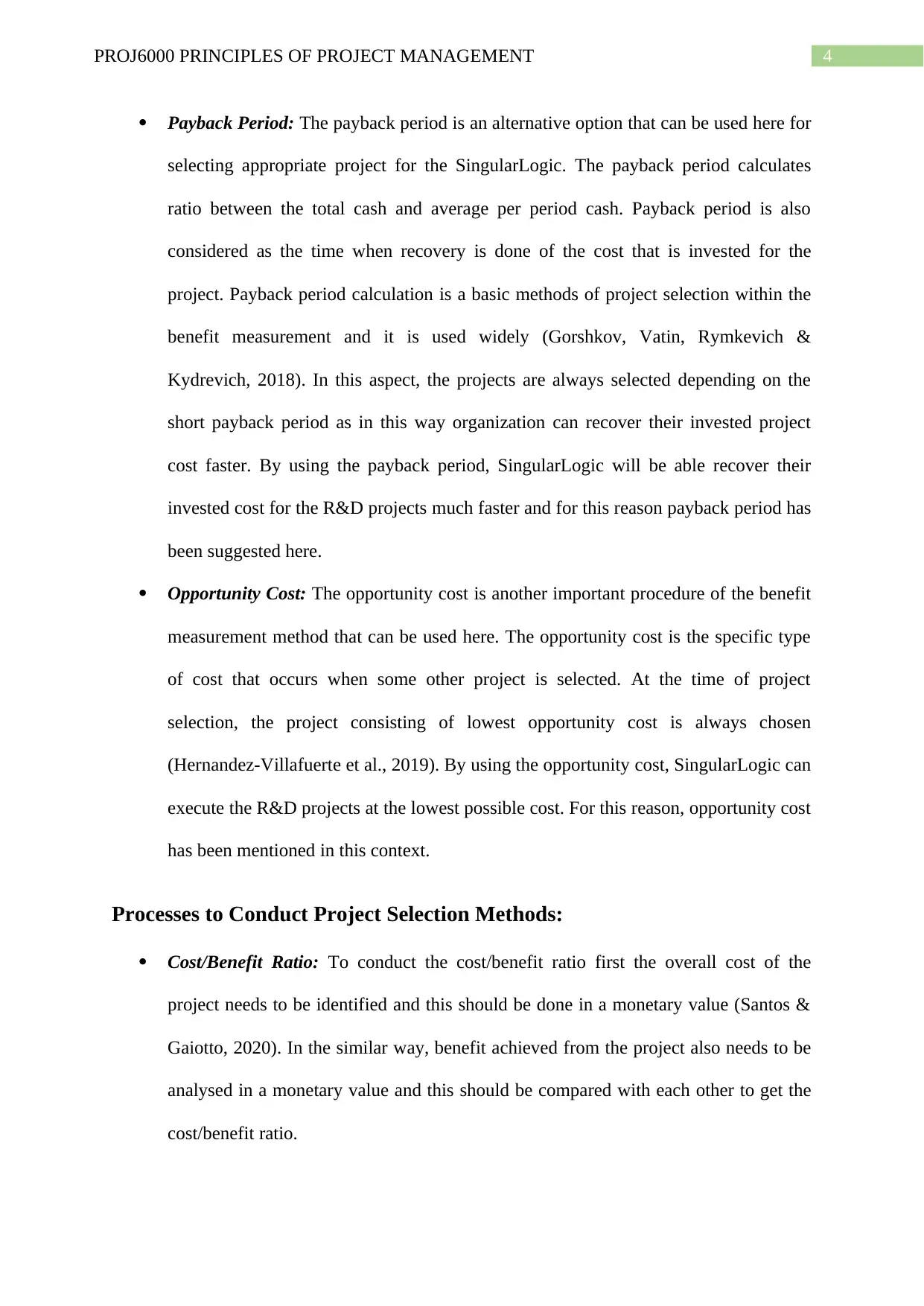
4PROJ6000 PRINCIPLES OF PROJECT MANAGEMENT
Payback Period: The payback period is an alternative option that can be used here for
selecting appropriate project for the SingularLogic. The payback period calculates
ratio between the total cash and average per period cash. Payback period is also
considered as the time when recovery is done of the cost that is invested for the
project. Payback period calculation is a basic methods of project selection within the
benefit measurement and it is used widely (Gorshkov, Vatin, Rymkevich &
Kydrevich, 2018). In this aspect, the projects are always selected depending on the
short payback period as in this way organization can recover their invested project
cost faster. By using the payback period, SingularLogic will be able recover their
invested cost for the R&D projects much faster and for this reason payback period has
been suggested here.
Opportunity Cost: The opportunity cost is another important procedure of the benefit
measurement method that can be used here. The opportunity cost is the specific type
of cost that occurs when some other project is selected. At the time of project
selection, the project consisting of lowest opportunity cost is always chosen
(Hernandez-Villafuerte et al., 2019). By using the opportunity cost, SingularLogic can
execute the R&D projects at the lowest possible cost. For this reason, opportunity cost
has been mentioned in this context.
Processes to Conduct Project Selection Methods:
Cost/Benefit Ratio: To conduct the cost/benefit ratio first the overall cost of the
project needs to be identified and this should be done in a monetary value (Santos &
Gaiotto, 2020). In the similar way, benefit achieved from the project also needs to be
analysed in a monetary value and this should be compared with each other to get the
cost/benefit ratio.
Payback Period: The payback period is an alternative option that can be used here for
selecting appropriate project for the SingularLogic. The payback period calculates
ratio between the total cash and average per period cash. Payback period is also
considered as the time when recovery is done of the cost that is invested for the
project. Payback period calculation is a basic methods of project selection within the
benefit measurement and it is used widely (Gorshkov, Vatin, Rymkevich &
Kydrevich, 2018). In this aspect, the projects are always selected depending on the
short payback period as in this way organization can recover their invested project
cost faster. By using the payback period, SingularLogic will be able recover their
invested cost for the R&D projects much faster and for this reason payback period has
been suggested here.
Opportunity Cost: The opportunity cost is another important procedure of the benefit
measurement method that can be used here. The opportunity cost is the specific type
of cost that occurs when some other project is selected. At the time of project
selection, the project consisting of lowest opportunity cost is always chosen
(Hernandez-Villafuerte et al., 2019). By using the opportunity cost, SingularLogic can
execute the R&D projects at the lowest possible cost. For this reason, opportunity cost
has been mentioned in this context.
Processes to Conduct Project Selection Methods:
Cost/Benefit Ratio: To conduct the cost/benefit ratio first the overall cost of the
project needs to be identified and this should be done in a monetary value (Santos &
Gaiotto, 2020). In the similar way, benefit achieved from the project also needs to be
analysed in a monetary value and this should be compared with each other to get the
cost/benefit ratio.
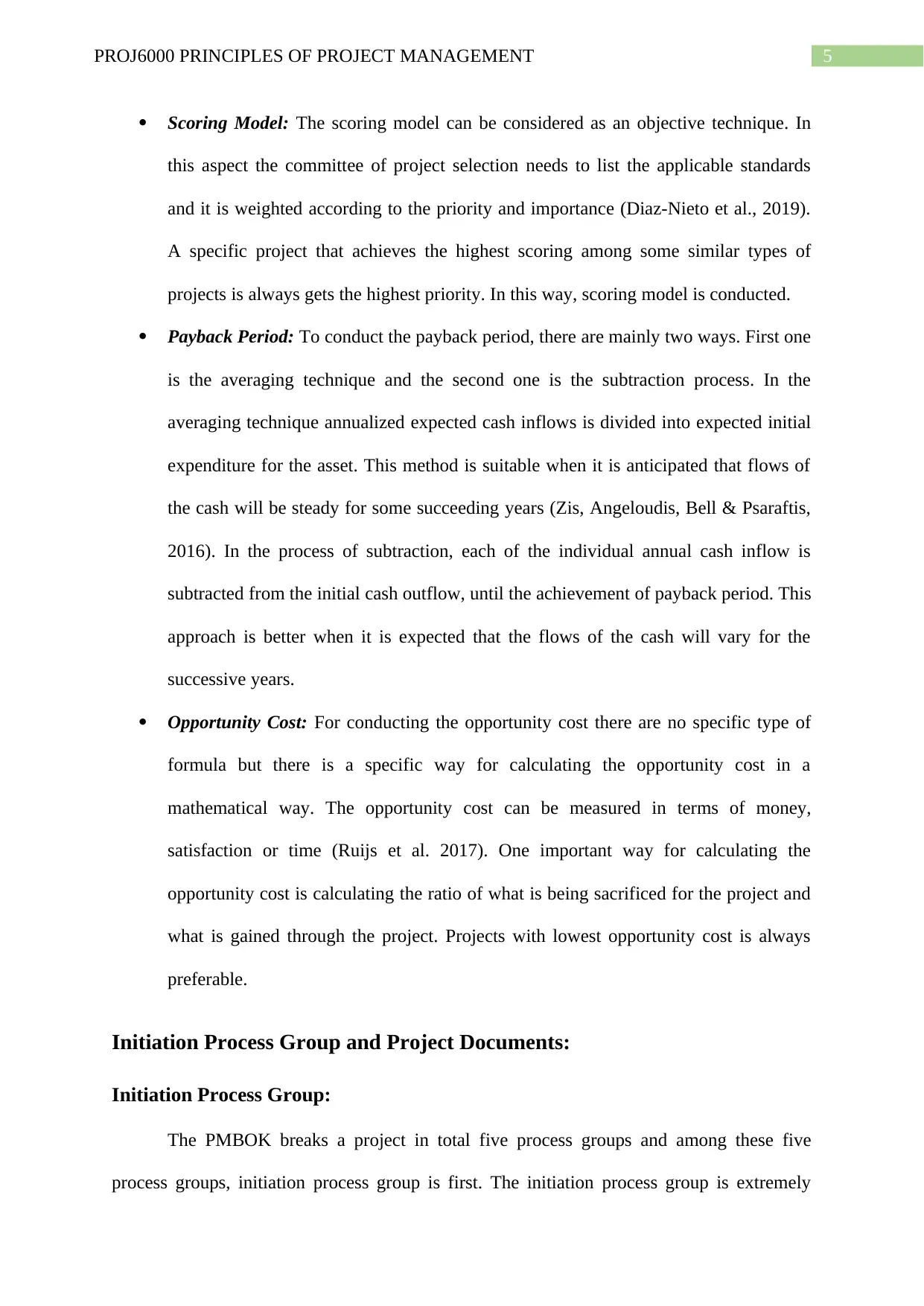
5PROJ6000 PRINCIPLES OF PROJECT MANAGEMENT
Scoring Model: The scoring model can be considered as an objective technique. In
this aspect the committee of project selection needs to list the applicable standards
and it is weighted according to the priority and importance (Diaz-Nieto et al., 2019).
A specific project that achieves the highest scoring among some similar types of
projects is always gets the highest priority. In this way, scoring model is conducted.
Payback Period: To conduct the payback period, there are mainly two ways. First one
is the averaging technique and the second one is the subtraction process. In the
averaging technique annualized expected cash inflows is divided into expected initial
expenditure for the asset. This method is suitable when it is anticipated that flows of
the cash will be steady for some succeeding years (Zis, Angeloudis, Bell & Psaraftis,
2016). In the process of subtraction, each of the individual annual cash inflow is
subtracted from the initial cash outflow, until the achievement of payback period. This
approach is better when it is expected that the flows of the cash will vary for the
successive years.
Opportunity Cost: For conducting the opportunity cost there are no specific type of
formula but there is a specific way for calculating the opportunity cost in a
mathematical way. The opportunity cost can be measured in terms of money,
satisfaction or time (Ruijs et al. 2017). One important way for calculating the
opportunity cost is calculating the ratio of what is being sacrificed for the project and
what is gained through the project. Projects with lowest opportunity cost is always
preferable.
Initiation Process Group and Project Documents:
Initiation Process Group:
The PMBOK breaks a project in total five process groups and among these five
process groups, initiation process group is first. The initiation process group is extremely
Scoring Model: The scoring model can be considered as an objective technique. In
this aspect the committee of project selection needs to list the applicable standards
and it is weighted according to the priority and importance (Diaz-Nieto et al., 2019).
A specific project that achieves the highest scoring among some similar types of
projects is always gets the highest priority. In this way, scoring model is conducted.
Payback Period: To conduct the payback period, there are mainly two ways. First one
is the averaging technique and the second one is the subtraction process. In the
averaging technique annualized expected cash inflows is divided into expected initial
expenditure for the asset. This method is suitable when it is anticipated that flows of
the cash will be steady for some succeeding years (Zis, Angeloudis, Bell & Psaraftis,
2016). In the process of subtraction, each of the individual annual cash inflow is
subtracted from the initial cash outflow, until the achievement of payback period. This
approach is better when it is expected that the flows of the cash will vary for the
successive years.
Opportunity Cost: For conducting the opportunity cost there are no specific type of
formula but there is a specific way for calculating the opportunity cost in a
mathematical way. The opportunity cost can be measured in terms of money,
satisfaction or time (Ruijs et al. 2017). One important way for calculating the
opportunity cost is calculating the ratio of what is being sacrificed for the project and
what is gained through the project. Projects with lowest opportunity cost is always
preferable.
Initiation Process Group and Project Documents:
Initiation Process Group:
The PMBOK breaks a project in total five process groups and among these five
process groups, initiation process group is first. The initiation process group is extremely
⊘ This is a preview!⊘
Do you want full access?
Subscribe today to unlock all pages.

Trusted by 1+ million students worldwide
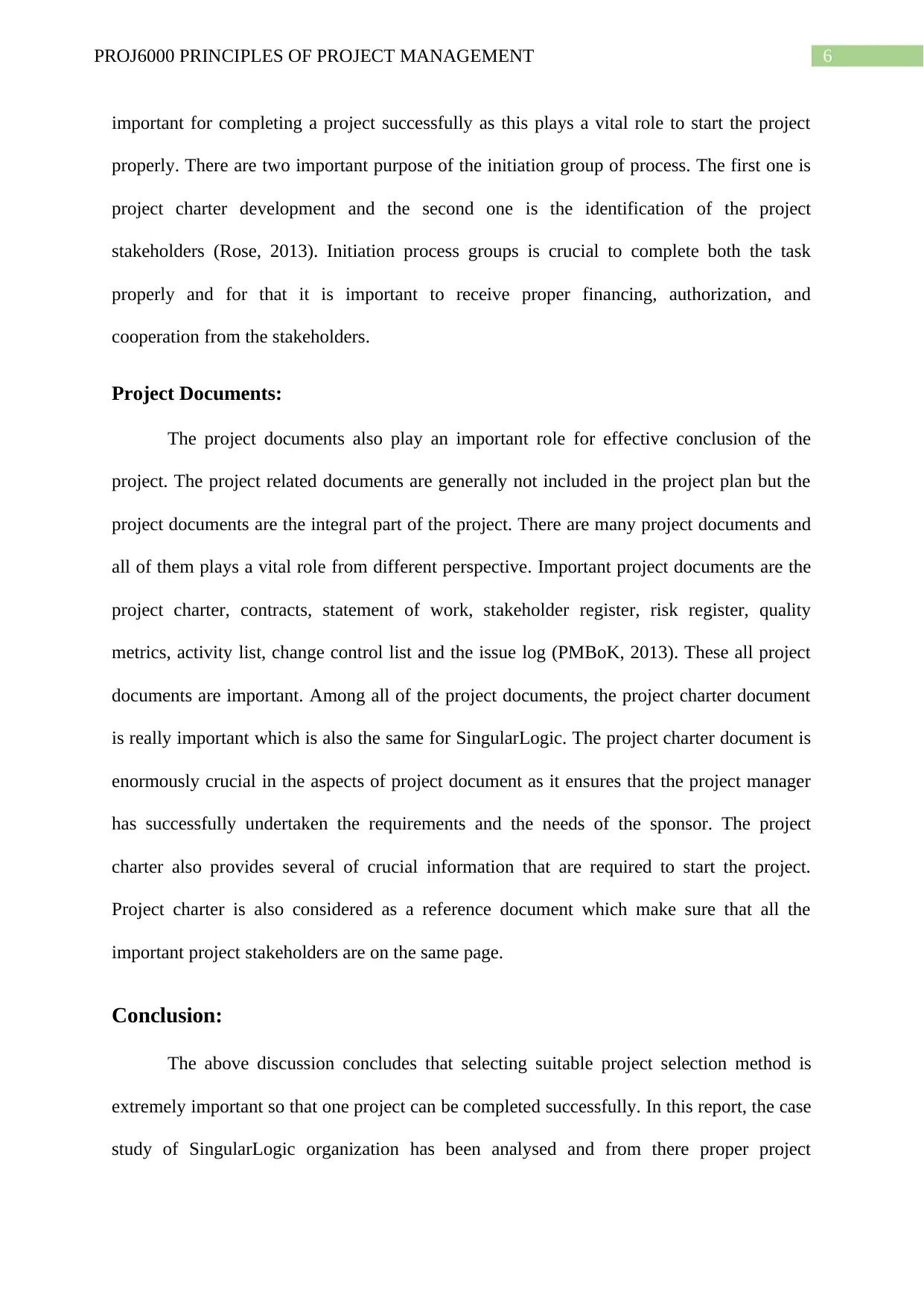
6PROJ6000 PRINCIPLES OF PROJECT MANAGEMENT
important for completing a project successfully as this plays a vital role to start the project
properly. There are two important purpose of the initiation group of process. The first one is
project charter development and the second one is the identification of the project
stakeholders (Rose, 2013). Initiation process groups is crucial to complete both the task
properly and for that it is important to receive proper financing, authorization, and
cooperation from the stakeholders.
Project Documents:
The project documents also play an important role for effective conclusion of the
project. The project related documents are generally not included in the project plan but the
project documents are the integral part of the project. There are many project documents and
all of them plays a vital role from different perspective. Important project documents are the
project charter, contracts, statement of work, stakeholder register, risk register, quality
metrics, activity list, change control list and the issue log (PMBoK, 2013). These all project
documents are important. Among all of the project documents, the project charter document
is really important which is also the same for SingularLogic. The project charter document is
enormously crucial in the aspects of project document as it ensures that the project manager
has successfully undertaken the requirements and the needs of the sponsor. The project
charter also provides several of crucial information that are required to start the project.
Project charter is also considered as a reference document which make sure that all the
important project stakeholders are on the same page.
Conclusion:
The above discussion concludes that selecting suitable project selection method is
extremely important so that one project can be completed successfully. In this report, the case
study of SingularLogic organization has been analysed and from there proper project
important for completing a project successfully as this plays a vital role to start the project
properly. There are two important purpose of the initiation group of process. The first one is
project charter development and the second one is the identification of the project
stakeholders (Rose, 2013). Initiation process groups is crucial to complete both the task
properly and for that it is important to receive proper financing, authorization, and
cooperation from the stakeholders.
Project Documents:
The project documents also play an important role for effective conclusion of the
project. The project related documents are generally not included in the project plan but the
project documents are the integral part of the project. There are many project documents and
all of them plays a vital role from different perspective. Important project documents are the
project charter, contracts, statement of work, stakeholder register, risk register, quality
metrics, activity list, change control list and the issue log (PMBoK, 2013). These all project
documents are important. Among all of the project documents, the project charter document
is really important which is also the same for SingularLogic. The project charter document is
enormously crucial in the aspects of project document as it ensures that the project manager
has successfully undertaken the requirements and the needs of the sponsor. The project
charter also provides several of crucial information that are required to start the project.
Project charter is also considered as a reference document which make sure that all the
important project stakeholders are on the same page.
Conclusion:
The above discussion concludes that selecting suitable project selection method is
extremely important so that one project can be completed successfully. In this report, the case
study of SingularLogic organization has been analysed and from there proper project
Paraphrase This Document
Need a fresh take? Get an instant paraphrase of this document with our AI Paraphraser
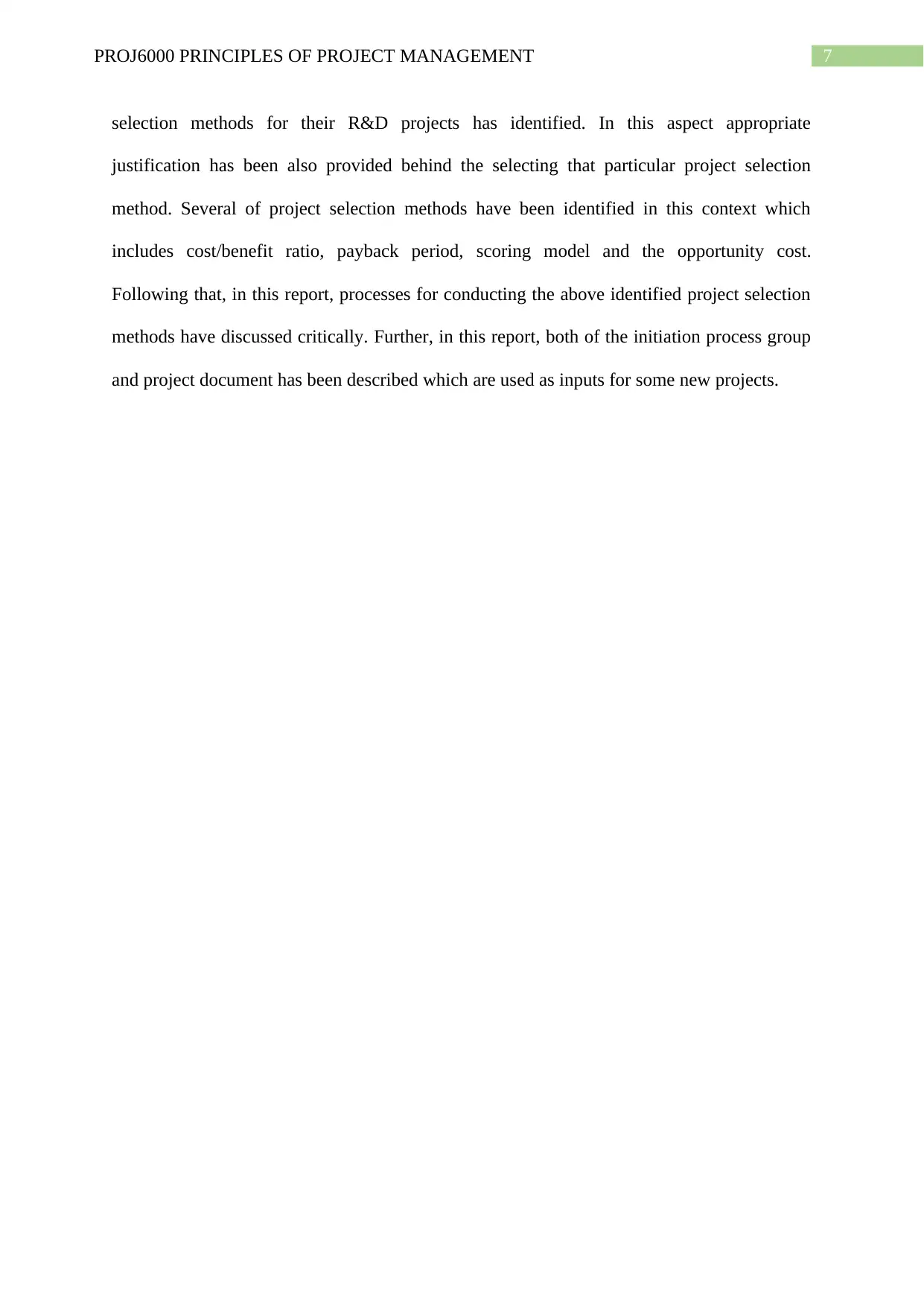
7PROJ6000 PRINCIPLES OF PROJECT MANAGEMENT
selection methods for their R&D projects has identified. In this aspect appropriate
justification has been also provided behind the selecting that particular project selection
method. Several of project selection methods have been identified in this context which
includes cost/benefit ratio, payback period, scoring model and the opportunity cost.
Following that, in this report, processes for conducting the above identified project selection
methods have discussed critically. Further, in this report, both of the initiation process group
and project document has been described which are used as inputs for some new projects.
selection methods for their R&D projects has identified. In this aspect appropriate
justification has been also provided behind the selecting that particular project selection
method. Several of project selection methods have been identified in this context which
includes cost/benefit ratio, payback period, scoring model and the opportunity cost.
Following that, in this report, processes for conducting the above identified project selection
methods have discussed critically. Further, in this report, both of the initiation process group
and project document has been described which are used as inputs for some new projects.
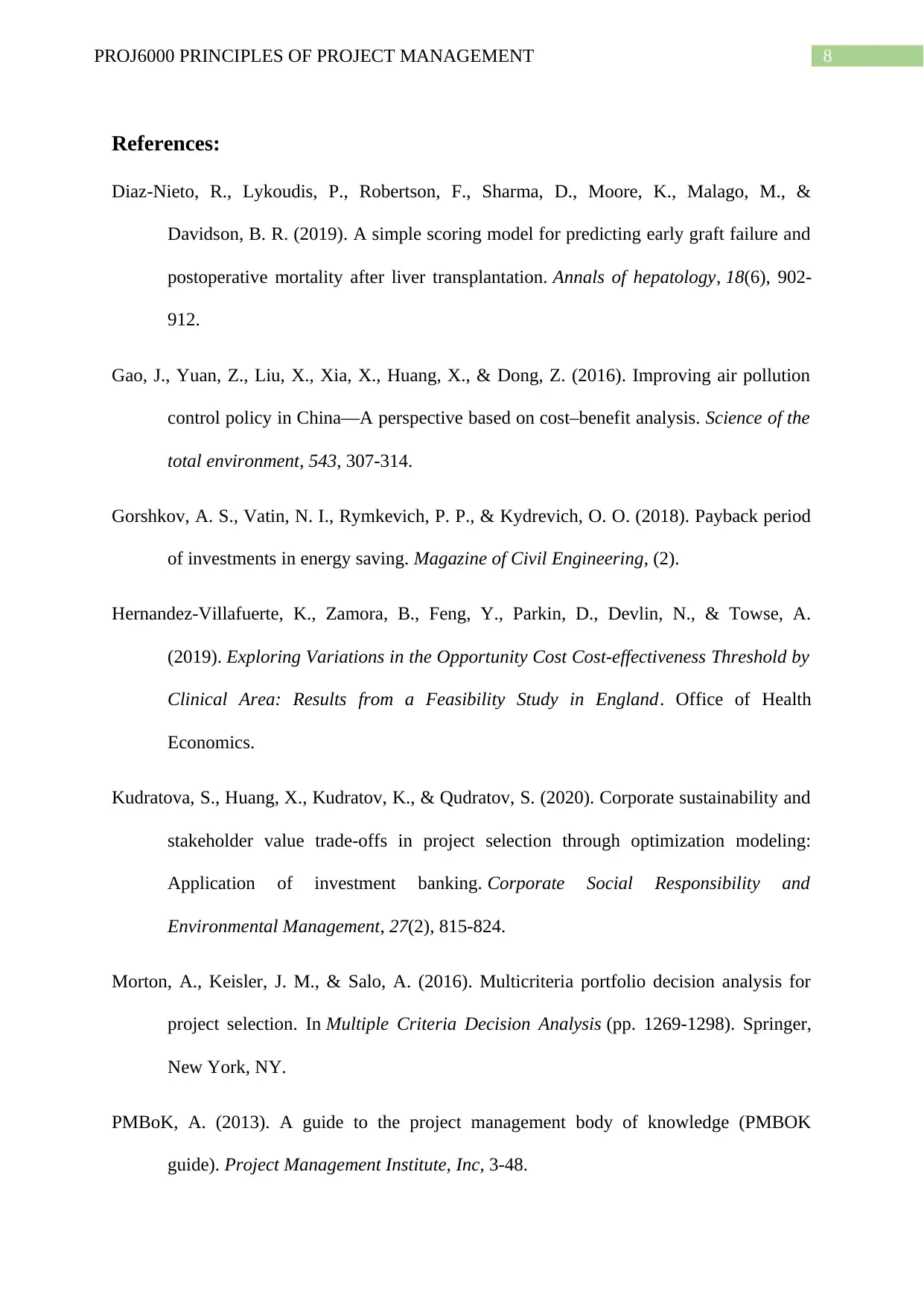
8PROJ6000 PRINCIPLES OF PROJECT MANAGEMENT
References:
Diaz-Nieto, R., Lykoudis, P., Robertson, F., Sharma, D., Moore, K., Malago, M., &
Davidson, B. R. (2019). A simple scoring model for predicting early graft failure and
postoperative mortality after liver transplantation. Annals of hepatology, 18(6), 902-
912.
Gao, J., Yuan, Z., Liu, X., Xia, X., Huang, X., & Dong, Z. (2016). Improving air pollution
control policy in China—A perspective based on cost–benefit analysis. Science of the
total environment, 543, 307-314.
Gorshkov, A. S., Vatin, N. I., Rymkevich, P. P., & Kydrevich, O. O. (2018). Payback period
of investments in energy saving. Magazine of Civil Engineering, (2).
Hernandez-Villafuerte, K., Zamora, B., Feng, Y., Parkin, D., Devlin, N., & Towse, A.
(2019). Exploring Variations in the Opportunity Cost Cost-effectiveness Threshold by
Clinical Area: Results from a Feasibility Study in England. Office of Health
Economics.
Kudratova, S., Huang, X., Kudratov, K., & Qudratov, S. (2020). Corporate sustainability and
stakeholder value trade‐offs in project selection through optimization modeling:
Application of investment banking. Corporate Social Responsibility and
Environmental Management, 27(2), 815-824.
Morton, A., Keisler, J. M., & Salo, A. (2016). Multicriteria portfolio decision analysis for
project selection. In Multiple Criteria Decision Analysis (pp. 1269-1298). Springer,
New York, NY.
PMBoK, A. (2013). A guide to the project management body of knowledge (PMBOK
guide). Project Management Institute, Inc, 3-48.
References:
Diaz-Nieto, R., Lykoudis, P., Robertson, F., Sharma, D., Moore, K., Malago, M., &
Davidson, B. R. (2019). A simple scoring model for predicting early graft failure and
postoperative mortality after liver transplantation. Annals of hepatology, 18(6), 902-
912.
Gao, J., Yuan, Z., Liu, X., Xia, X., Huang, X., & Dong, Z. (2016). Improving air pollution
control policy in China—A perspective based on cost–benefit analysis. Science of the
total environment, 543, 307-314.
Gorshkov, A. S., Vatin, N. I., Rymkevich, P. P., & Kydrevich, O. O. (2018). Payback period
of investments in energy saving. Magazine of Civil Engineering, (2).
Hernandez-Villafuerte, K., Zamora, B., Feng, Y., Parkin, D., Devlin, N., & Towse, A.
(2019). Exploring Variations in the Opportunity Cost Cost-effectiveness Threshold by
Clinical Area: Results from a Feasibility Study in England. Office of Health
Economics.
Kudratova, S., Huang, X., Kudratov, K., & Qudratov, S. (2020). Corporate sustainability and
stakeholder value trade‐offs in project selection through optimization modeling:
Application of investment banking. Corporate Social Responsibility and
Environmental Management, 27(2), 815-824.
Morton, A., Keisler, J. M., & Salo, A. (2016). Multicriteria portfolio decision analysis for
project selection. In Multiple Criteria Decision Analysis (pp. 1269-1298). Springer,
New York, NY.
PMBoK, A. (2013). A guide to the project management body of knowledge (PMBOK
guide). Project Management Institute, Inc, 3-48.
⊘ This is a preview!⊘
Do you want full access?
Subscribe today to unlock all pages.

Trusted by 1+ million students worldwide
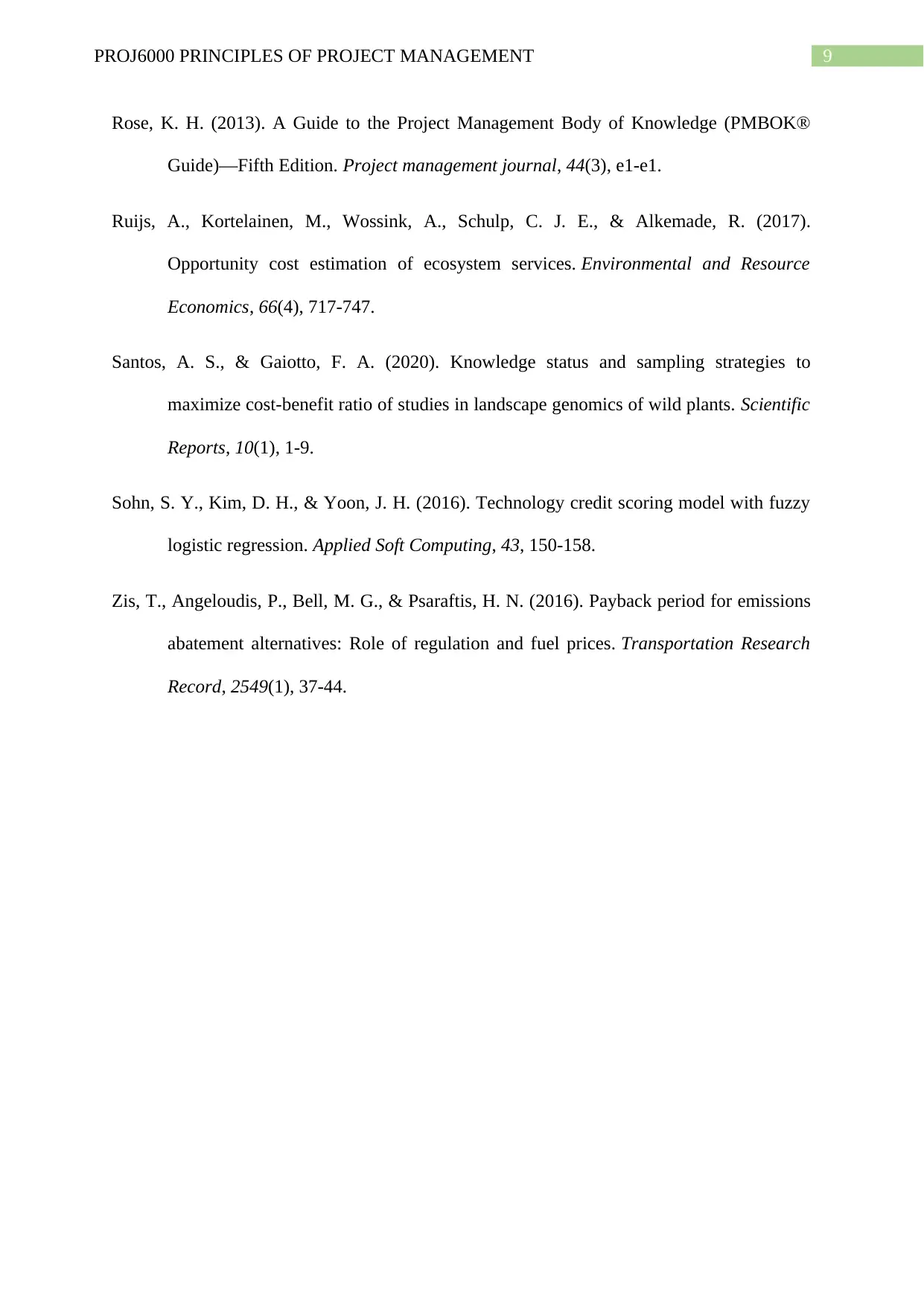
9PROJ6000 PRINCIPLES OF PROJECT MANAGEMENT
Rose, K. H. (2013). A Guide to the Project Management Body of Knowledge (PMBOK®
Guide)—Fifth Edition. Project management journal, 44(3), e1-e1.
Ruijs, A., Kortelainen, M., Wossink, A., Schulp, C. J. E., & Alkemade, R. (2017).
Opportunity cost estimation of ecosystem services. Environmental and Resource
Economics, 66(4), 717-747.
Santos, A. S., & Gaiotto, F. A. (2020). Knowledge status and sampling strategies to
maximize cost-benefit ratio of studies in landscape genomics of wild plants. Scientific
Reports, 10(1), 1-9.
Sohn, S. Y., Kim, D. H., & Yoon, J. H. (2016). Technology credit scoring model with fuzzy
logistic regression. Applied Soft Computing, 43, 150-158.
Zis, T., Angeloudis, P., Bell, M. G., & Psaraftis, H. N. (2016). Payback period for emissions
abatement alternatives: Role of regulation and fuel prices. Transportation Research
Record, 2549(1), 37-44.
Rose, K. H. (2013). A Guide to the Project Management Body of Knowledge (PMBOK®
Guide)—Fifth Edition. Project management journal, 44(3), e1-e1.
Ruijs, A., Kortelainen, M., Wossink, A., Schulp, C. J. E., & Alkemade, R. (2017).
Opportunity cost estimation of ecosystem services. Environmental and Resource
Economics, 66(4), 717-747.
Santos, A. S., & Gaiotto, F. A. (2020). Knowledge status and sampling strategies to
maximize cost-benefit ratio of studies in landscape genomics of wild plants. Scientific
Reports, 10(1), 1-9.
Sohn, S. Y., Kim, D. H., & Yoon, J. H. (2016). Technology credit scoring model with fuzzy
logistic regression. Applied Soft Computing, 43, 150-158.
Zis, T., Angeloudis, P., Bell, M. G., & Psaraftis, H. N. (2016). Payback period for emissions
abatement alternatives: Role of regulation and fuel prices. Transportation Research
Record, 2549(1), 37-44.
1 out of 10
Related Documents
Your All-in-One AI-Powered Toolkit for Academic Success.
+13062052269
info@desklib.com
Available 24*7 on WhatsApp / Email
![[object Object]](/_next/static/media/star-bottom.7253800d.svg)
Unlock your academic potential
Copyright © 2020–2025 A2Z Services. All Rights Reserved. Developed and managed by ZUCOL.





